Brief Introduction to History
of Medicine in Britain
Hunterian
Museum (Royal College of Surgeons, England)
Wellcome
Museum in London
Royal
College of Surgeons, Edinburgh
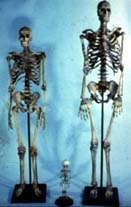
|
ロンドンのcityと繁華街の境目、地下鉄(tube)のHolborn駅からテムズ川に向かって徒歩数分、左側一帯のLincoln's
Inn Fields
にかっての理髪外科医組合から発展したRoyal
College of Surgeons,
England(王立外科医連合)がある。そのGeorgian風の建物の2階にあがると、広々とした展示室があるが普段はほとんど訪れる観光客はいない。この展示室がHunterian
Museumといわれる300年近い歴史を持つ博物館である。一般には公開していないためあらかじめ予約が必要だが、イギリスを訪れる際にはSohoハやPiccadilly
Circusの喧噪を離れ過去への歴史散歩をするにはうってつけの場所である。この博物館の入り口正面に飾られている合体骨格標本がここで紹介する「アイルランドの巨人」の骨格標本である。
|
|
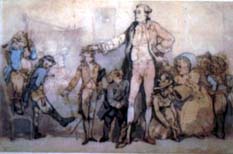
|
この「アイルランドの巨人」は生前O'Brianといい、身長が2m30cmもあったという。貧しいアイルランドから出稼ぎにロンドンに出てきたものの、その奇怪な容貌とアイルランド人への差別(ほんの少し前までロンドンの簡易旅館などには"No
dogs, No
Irish"という看板が見られたという)とで、正業につけるはずがなかった。そこで彼が選んだ道はサーカスで自分の巨体を人前にさらして日銭を得るということであった。サーカスといえば聞こえはよいが、おそらく小さな見せ物小屋のようなものであったのではなかろうか。彼が300年たった現在骨格標本として手厚い扱いを受けているのは、その見せ物小屋へ偶然John
Hunter(1728-1793)が立ち寄ったことからであった。
|
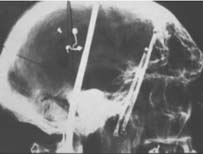
|
Irish Giantのレントゲン写真。
脳下垂体疾患の患者に巨人が多いことに気づいていたHarvey
Cushingが英国を訪れてIrish
Giantのレントゲンを撮影し、下垂体腺腫に特徴的な所見を見いだした。巨人症が下垂体腺腫でおきるという証明に寄与した重要な写真である。
|
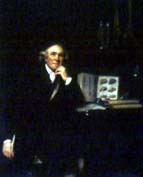 John Hunter
(1728-1793)
John Hunter
(1728-1793)
|
Hunterは現在では近代外科学の父ともいわれ、医学の歴史に残っている人物である。しかし実際は医師にはなれず兄の開業する外科医院で助手のようなことをしていた。幼小時から読み書きが十分にできず、学校の勉学についていけないため中退したという。おそらく現在でいう学習障害児の範疇にはいると思われるが、しばしばこのような人間にはなにかきらめくような才能が隠されているものである。彼の才能は、精細な絵を書いたり標本を作製することであった。現在彼の書いた絵や標本は多数残っているが、文字で記載されたものはほとんどない。これはソクラテスやレオナルド・ダ・ビンチにも共通しており、ソクラテスの場合は弟子が口述筆記したものが受け継がれていだけで、ダ・ビンチにも著作と呼べるようなものはない。おそらく彼らは現在の知識ではdyslexiaという「脳障害」に分類されるのではないかと思われる。
|
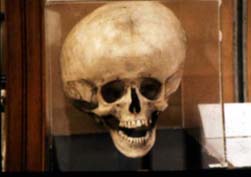
|

|
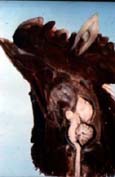
|
|
水頭症の頭蓋骨標本
|
achondroplasiaの骨格標本
|
鶏の頭蓋骨に人間の歯を移植したもの
|
John Hunterが作製した標本類
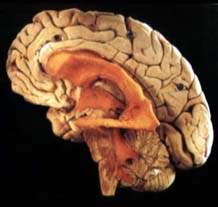
|
Waxを注入して作ったヒトの脳室の鋳型
Hunterは様々な動物の脳室でこのような鋳型を作製している
Wax cast of the ventricles. Hunter
made such casts in various animals.
|
[Go Home]
[Go top]
Museums of The Royal
College of Surgeons
(Hunterian Museum)
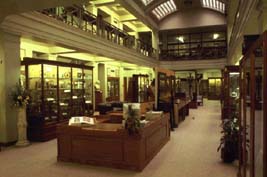 Introduction
Introduction
In 1799 the Government of the day purchased the
collection of John Hunter FRS (1728-1793) the important anatomist,
surgeon, researcher and teacher. It was placed in the care of The
Royal College of Surgeons in 1800. Hunter's collection of 17,000
preparations of human, animal and plant material formed the nucleus
of the museum. By 1941 when the College suffered extensive bomb
damage, it held over 65,000 specimens. Much of the surviving material
was relocated in the present four College Museums. They are:
Hunterian
Museum , Odontological Museum , Wellcome Museum of Anatomy , Wellcome
Museum of Pathology
The Museums are open to all members and
students of the medical, nursing, dental and scientific societies and
to other serious visitors and researchers, staff and visitors to the
College. Children under 14 are admitted only if accompanied by an
adult. It is advisable to telephone ahead to book a visit. Contact
the Museums Secretary on +44 (0)171 973 2190.
Guided tours and access to material can be
arranged with museum staff. There is no admission charge but
donations are welcome. Disabled access by arrangement. Please note
the Wellcome Museums are closed when in use for examinations and
special courses. [Go Home]
[Go top]
Medical
Part of the Science
Museum in London
On the coach (bus) from Heathrow Airport to the
downtown London, you can find a beautiful Victorian architecture of
Natural History Museum. The Science Museum is just at the back of
this building.
The museum houses Britain's greatest collection
of science and industry, with examples and illustrations of machines,
apparatus and scientific discovery. From Stephenson's Rocket to the
Apollo 10 spacecraft the diversity of the objects range through
transport, food, chemicals, mechanical apparatus, power, optics,
telecommunications, geophysics, photography and medicine.
The two floors of Medical
History are due largely to the
collecting zeal of Sir Henry Wellcome. During the last 40 years of
his life (he died in 1936) he amassed a vast number of objects,
books, letters and paintings, many of which have been on display at
the Science Museum since 1982. The 'Science of Art and Medicine' has
a chronological display of medical items from the Egyptians, Greeks
and Romans to 20th century laboratory medicine, the influences of
conflict and exploration on medicine, and medicine in the third
world. The gallery on the 4th floor, "Glimpses of Medical History"
contains a series of reconstructions, dioramas and models from a
Neolithic trepanning operation to a 1980 heart operation. A large
gallery is also devoted to veterinary medicine.
(The following pictures are taken by
T.Taira, I hope there is no problem about copyright)
|
|
Trepanned skull (rt) more
than 3000 years ago
Bone flap replaced (rt,
about 300 years ago)
|
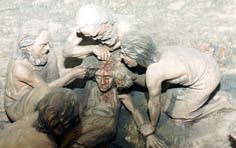
|
Trepanning in the battle
field
|
 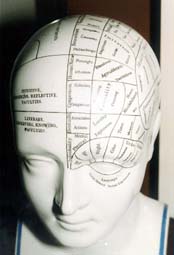
|
Phrenology
Note that the left side of
the head is more occupied with functions.
|
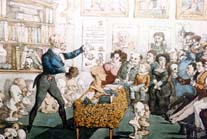
|
Lectures on
Phrenology
|
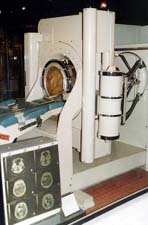
|
The first CT scan (EMI
scan)
|
[Go Home]
[Go top]
Royal College of
Surgeons in Edinburgh
エジンバラはBell、Monroなどの神経学の歴史上の人物がいたところです。ここには頭蓋骨の奇型などの貴重な資料が数多く展示されています。
The Royal College of Surgeons of Edinburgh has
three distinct museums: the classical Playfair Hall with its major
displays of pathological anatomy; the Sir Jules Thorn Exhibition of
the History of Surgery; and the Dental Museum. The Museums are
available each weekday as sites for anatomical and pathological
study. The Sir Jules Thorn Historical Exhibition is open to the
public between 2 - 4pm, Monday to Friday.
- Playfair Hall
- Situated in the upper floor of the
Playfair building, the Museum has one of the largest
collections of pathological anatomy in the United Kingdom and
provides valuable material for the study of human disease. The
collection contains much material for postgraduate students of
surgery and dental surgery. The Playfair Hall and the College
itself can be visited by Fellows of the College without prior
arrangement. Members of the public may arrange access, by
written arrangement through the Honorary Conservator of the
Museum, Professor D L Gardner. Visiting parties, normally
limited to 24 in number, are taken round by a guide. No person
under the age of 15 years is admitted without special
permission. A charge is made for the tour. For further
information contact the Museum Office. Tel 0131-527-1649, Fax
0131-557-6406.
- Sir Jules Thorn Historical
Exhibition
- The Sir Jules Thorn Exhibition, adjacent
to the Playfair Hall, is a display illustrating the scope of
modern surgery. It includes examples of the surgical
specialties. The Exhibition also describes the History of
Surgery and Edinburgh on special contribution to surgical
practice from ancient to modern times.
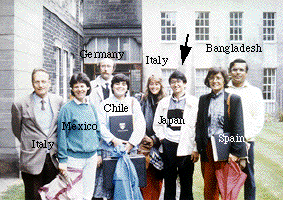
各国からの医師たちとともにRoyal College of
Surgeons in Edinburghにてトレーニングを受けていた頃の私(1988年)
[Go Home] [Go
top]


